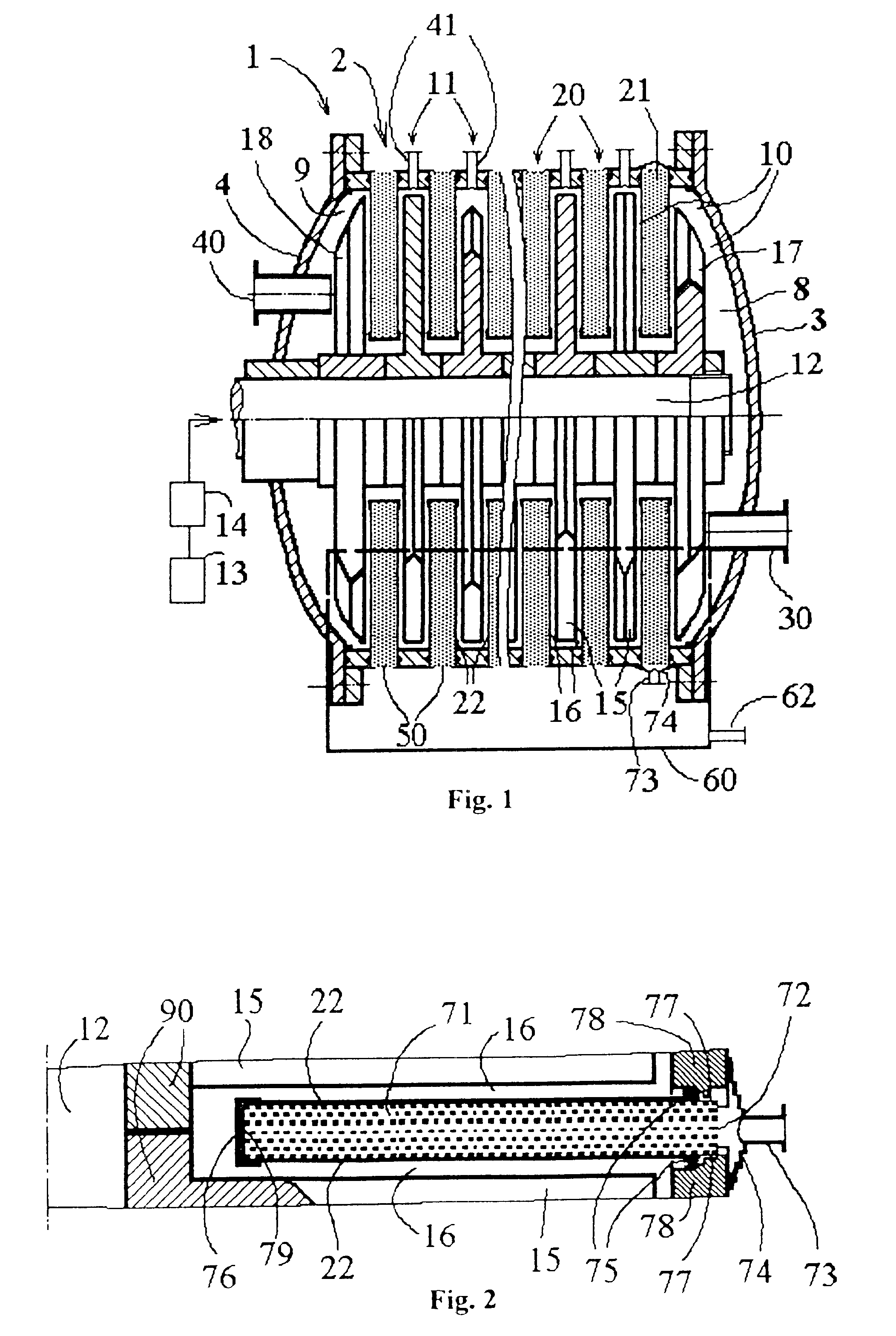Apparatus, system and method for separating liquids
a technology of apparatuses and liquids, applied in the field of apparatuses for liquid separation, can solve the problems of complex apparatuses, mechanical complexity, and wear, bulkiness and adjustment, and achieve the effect of maximizing the resistance of membranes to clogging thereo
- Summary
- Abstract
- Description
- Claims
- Application Information
AI Technical Summary
Benefits of technology
Problems solved by technology
Method used
Image
Examples
first embodiment
Referring to FIG. 1, the apparatus for membrane separation is described. Apparatus for membrane separation 1 includes fixed cylindrical housing 2 separated with membranes into two compartments. First compartment 10 contains the liquid, second compartment 20 contains the treated liquid, i.e. the permeate or filtrate. The apparatus for membrane separation includes:
at least one common liquid inlet means 30 mounted on first end wall 3, between shaft 12 and the outer edge of this end wall, said apparatus 30 being connected to extreme liquid inlet cell 8;
at least one common liquid outlet means 40 mounted on second end wall 4, between shaft 12 and the outer edge of this end wall, said apparatus 40 being connected to extreme liquid outlet cell 9;
at least one permeate outlet means 50 and / or 73.
Each intermediate cell 11 of the apparatus for membrane separation has at least one peripheral liquid outlet means 41. The ratio of apparatus 40 liquid flow rate to a sum of the rates of flow through l...
second embodiment
FIG. 5 provides a schematic representation of the apparatus for membrane separation. This figure uses the designations of FIG. 1 to identify the parts which are common for the two embodiments of the apparatus for membrane separation.
In the second embodiment, the apparatus for membrane separation includes axial liquid inlet means 31; being connected to hollow shaft 19, this apparatus is located in first end wall 3 of apparatus for membrane separation 1. To introduce the liquid into each cell of the apparatus for membrane separation, use if made of radial bores 32 made in the shaft wall at the level of each permeate chamber and radial bores 33 made in central ring 90 of each impeller. The impellers are so set on the shaft that the aforementioned bores in the shaft wall and in the central rings of the impellers coincide with each other. The liquid leaves the apparatus for membrane separation via a common liquid outlet means 40 where its flow is caused to oscillate by rotation of extrem...
third embodiment
FIG. 6 provides a schematic representation of the apparatus for membrane separation. This figure uses the designations of FIGS. 1 and 5 to identify the parts which are common for the three embodiments of the apparatus for membrane separation.
In the third embodiment, the apparatus for membrane separation includes two liquid inlet means 30 and 31. This apparatus for membrane separation synthesizes the first and second embodiments of the invention and can be used to ensure better maintenance of the ratio of the liquid flows passing through each cell in the sequential manner and parallel manner.
Although FIGS. 1, 5, and 6 represent horizontal apparatus for membrane separationes (having a horizontal housing and shaft) the apparatus for membrane separation can be of vertical design which is presented by way of example in FIG. 7 (for the third embodiment). This figure uses the designations of FIGS. 1, 5 and 6 to identify the parts which are common for the three embodiments of the horizontal...
PUM
| Property | Measurement | Unit |
|---|---|---|
| Thickness | aaaaa | aaaaa |
| Thickness | aaaaa | aaaaa |
| Thickness | aaaaa | aaaaa |
Abstract
Description
Claims
Application Information
 Login to View More
Login to View More - R&D
- Intellectual Property
- Life Sciences
- Materials
- Tech Scout
- Unparalleled Data Quality
- Higher Quality Content
- 60% Fewer Hallucinations
Browse by: Latest US Patents, China's latest patents, Technical Efficacy Thesaurus, Application Domain, Technology Topic, Popular Technical Reports.
© 2025 PatSnap. All rights reserved.Legal|Privacy policy|Modern Slavery Act Transparency Statement|Sitemap|About US| Contact US: help@patsnap.com



